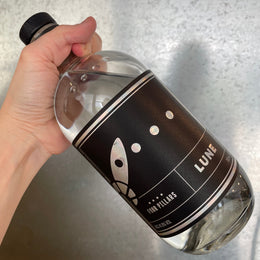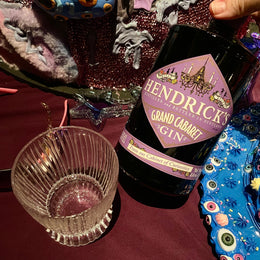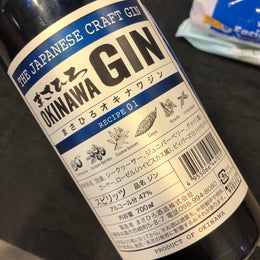
For those who love their gins, Colombo Gin and its almost newborn sibling, the Colombo 8, have been making their rounds in guest shifts and gin bars. While the gin has Today's gin escapade takes us to the mountainous region of Sri Lanka - and looking into the tale of grit that is Rockland Distillery.
![]()
The Rockland Distillery logo, unchanged since 1924, depicts two friends having a drink at the bar.
Coconut Country, Arrack Beginnings
Within the hot, tropical island of Sri Lanka, coconut plantations are in abundance - coconut sap being one of the main produce. Coconut sap isn't harvested from tree trunks as intuition would suggest - moreover, it is harvested from the flowers trees, where tappers would slice unopened flower stems to collect the sticky sweet liquid. That sticky liquid is heated to get palm sugar (or coconut sugar), and sometimes further processed to make vinegar.
![]()

Source: The Coconut Company
And you know, where there's sugar, it's bound to be made into alcohol. Toddy (also known by many other names) is the fermented product of this palm sugar liquid, usually at a 7.5% alcohol by volume. Further distilling this toddy would yield arrack, which is where the story of our distillery starts.
![]()
Toddy. Source: Asian Inspirations
The story of Rockland Distillery starts with two gentlemen - Joseph Boniface Michael (JBM) Pereira and Carl de Silva Wijeyeratne. The latter, Carl, was the nephew of his favourite uncle JBM Pereira. Both JBM Pereira and Carl were already familiar with the arrack business in the then British colony of Ceylon. Carl was abit of a curious man himself - tinkering with machines when young and initially wanted to pursue medicine.

JBM Pereira and Carl de Silva Wijeyeratne, the two men behind Rockland Distillery.
The uncle-nephew duo joined forced to open Sri Lanka's first distillery in the Rockland estate - importing still parts made in France and inviting a French engineer to get the distillery running. However, within six years of opening in 1924, JBM Pereria has passed on, leaving a bereaved Carl to helm the distillery.
![]()
And old picture of the 1924 distillery. Source: Rockland.lk
Weathering Laws, War, Fire
The early years were not easy. Colonial policies were discriminatory - for one, loans were not issued by the British bank to locals. Back then, only "local spirits" were allowed to be distilled in Ceylon. Carl found ways to work around these laws, and eventually, campaigned for “Country Made Foreign Spirits” - broadening the spirits being distilled to include gin. This is the precursor to today's gins, a recipe that has been in slumber for more than 70 years.

Source: Rockland (Facebook)
The distillery also pivoted to making neutral ethanol to support the war effort as well.
The road hasn't always been smooth sailing. In the 1970s, the distillery faced economic woes and competition, when another distillery opened up being exempt from taxes. Slightly over a decade later, the distillery was burned to the ground during the insurrections of late-1980s, where the site had to be shifted to a safer location. From the ashes, the distillery was re-built, this time with equipment from Germany. And again, in the 2004 Indian Ocean Typhoons, the distillery had to be rebuilt again.

Source: @colombo7gin
The distillery did not stop innovating - in 2009, Rockland Distillery was awarded the LEED (Leadership in Energy and Environmental Design) certification from the U.S. Green Building Council (last reviewed on 2012). Today, the distillery boasts a portfolio of gins, whiskies, arracks and other spirits. On future challenges, here's what fourth-generation Chairman Derek de Silva Wijeyeratne has to say:
![]()
Unlike many, our family, including my father, didn’t revel in lavish celebrations of success. Achievements were regarded as fulfilling our duty, nothing more. This work ethic has been a guiding principle for us.
So, What About the Gins?
The Colombo Gin (or sometimes referred to as the Colombo No. 7), was based off an old recipe since Carl's time. While gin was still very much a British thing then, Carl sought to create a version of his own.

A scan of the distillery's launch in 1924, on The Morning Leader Article. Source: Rockland.lk
This so happened to be the time when Britain was knee deep in World War II. Rations were in place, and Britain was in need of spirits - gin included. Sourcing botanicals from spice gardens, the first Sri Lankan gin was distilled - which allegedly, impressed British excise officers enough to allow the non-native spirits law to be passed. The laws would be known to be the CMFL (Ceylon Made Foreign Liqour), which would be extended to India as well, under the similarly named IMFL.
![]()
Source: AlphaMen
Amal, Carl's grandson, dug through the distillery's archives and found sought to recreate this old wartime gin recipe at Langley Distillery. The gin was officially launched in 2015, with the No.7 representing 7 spices:
Four native botanicals: cinnamon bark, curry leaves, ginger root, coriander seeds; alognside three others: juniper berries, liquorice and angelica.

The next itineration, the Colombo 8 Gin, was unveiled in 2023, just last year as of this article's posting - the eight ingredient being ginseng.

Source: @colombo7gin
We were introduced to these two gins by La Maison Du Whisky (Singapore) - where we've had a negroni made with the Colombo 8 gin.

I'll be reviewing these two gins neat.
Colombo Gin, 43.1% ABV - Review

Nose: There's a green sweetness to the gin, reminding me of freshly plucked coriander leaves and crushed coriander seeds. There's a lemony sort of aroma to the gin - subtle and reminiscent of fresh lemon sorbet.
Taste: Relatively light on flavour - like dried Italian herbs: thyme, a small hint of rosemary and parsley. There's a sweet white sugar taste and texture to the gin - a quick, plain sweetness that comes and goes. There's a bit of powdery bitterness, however very subtle.

Finish: A herbaceous finish - kind of like chewing in the stalk and leaf veins of basil and coriander. It's very subtle in the finish, but as it sits a powdery orris root powder flavour starts to arise.
My Thoughts
Rating: Easy going on its own, however, it does lack some nuance and complexity. The aromas are nice and bright on herbaceous and lemony aromas, but i feel more could have been expressed on the taste and finish. This gin definitely suit the profile for London Dry gin lovers.
Rating: 6/10
|
Score/Rating Scale :
|
Colombo No. 8 Gin, 43.7% ABV - Review

Nose: Quite green and weedy on the nose - I get a bouquet of tropical Asian herbs, like curry leaves, laksa leaves, bruised Thai basil and some peppermint. Underneath the spicy, prickly herbaceous scents, there is a medicinal sweetness behind the gin, something that reminds me of angelica roots or liquorice.
Taste: The standout flavour for me was the curry leaves - the initial burst of green leafy flavours give way to the distinct curry leaf. There is a subtle piney flavour in the gin, though very subtle, that gives backbone to the gin. While the green, herbaceous flavours taper off, there is some raw green chilli spiciness that takes over the palate.

Finish: Leaves a rather medicinal taste at the end - like a mix of medicinal roots like angelica, ginger, liquorice. There is a bit of that Korean ginseng candy sweet-dry flavours that linger on the palate a bit, but it is very subtle.
My Thoughts
Very safe, again. The standout flavour of curry leaf, while not offensive in any way, doesn’t make for much complexity or interest value. I feel that the ginseng is lost in the gin, or is too subtle and easily overpowered by the other stronger tasting botanicals in the gin.
That said, the gin is relatively muted on the juniper flavours. Perhaps behind the bar, this could make for a good base spirit for lighter, more floral or spicy cocktails. If someone’s looking for a greener, more grassy and spicy-herby gin, which happens to have less juniper flavours, this could make a good pick. However, I find this gin average and too safe for my liking.
Rating: 6/10
Let's quickly circle back to that negroni.

While the herbaceousness is there, the flavours go towards more bittersweet, root herbaceous moreso than the leafy, greener flavours when neat. I feel that more ginseng flavours make their presence here. Definitely a step up from drinking neat.
Maybe... I should give that arrack a try. Stay tuned!

@vernoncelli







